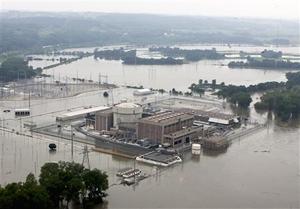DisastersNebraska floods test a nuclear power plants new safety measures
U.S. nuclear officials are closely monitoring two atomic energy plants in Nebraska that are in danger of being inundated with water as the Missouri River continues to creep ever closer; the Fort Calhoun nuclear plant has been closed for refueling since April and will remain off until the flooding subsides, but officials are worried about keeping the recently removed fuel rods cool as the facility’s parking lot has been flooded

Flood waters surround the Fort Calhoun plant // Source: shimotsuke.co.jp
U.S. nuclear officials are closely monitoring two atomic energy plants in Nebraska that are in danger of being inundated with water as the Missouri River continues to creep ever closer.
On Monday, Gregory Jaczko, the head of the U.S Nuclear Regulatory Commission (NRC) visited the Fort Calhoun nuclear plant located twenty miles north of Omaha to inspect its flood defenses.
The plant has been closed for refueling since April and will remain off until the flooding subsides, but officials are worried about keeping the recently removed fuel rods cool as the facility’s parking lot has been flooded.
Workers have been forced to enter the facility via a catwalk, and operators briefly switched over to diesel backup generators as flood waters got dangerously close to electrical transformers.
The latest floods are a test for the plant’s new defenses which were installed in response to an NRC inspection last year which deemed that its fortifications could fail against a 1,010 foot flood.
In the NRC’s report, investigators concluded that at flood levels above 1,008 feet, the plant “would experience a loss of offsite power and loss of intake structure” as well as critical water pumps that keep the nuclear fuel from overheating. With the loss of these functions, “the plant would be incapable of reaching cold shutdown.”
For additional protection, the Omaha Public Power District (OPPD), the plant’s operator, built new steel gates and other hard barriers to protect its auxiliary building, which houses critical controls, as well as an eight-foot water filled berm that circles parts of the plant. These new structures are designed to keep the facility safe from waters that reach 1,014 above sea level.
Last Sunday, workers also installed an additional inflatable water-filled barrier, and assured residents that the facility’s critical areas were not in danger of being damaged by flood waters.
So far the barriers seem to be holding, and on Monday, the NRC chairman said, “We don’t believe the plant is posing an immediate threat to the health and safety of the public.”
Meanwhile, Nebraska’s other nuclear plant, the Cooper Nuclear Station, is located on higher ground and remains operational. Officials there are keeping a close eye on flood waters as they are nearing critical levels and may force the plant to shut down.
